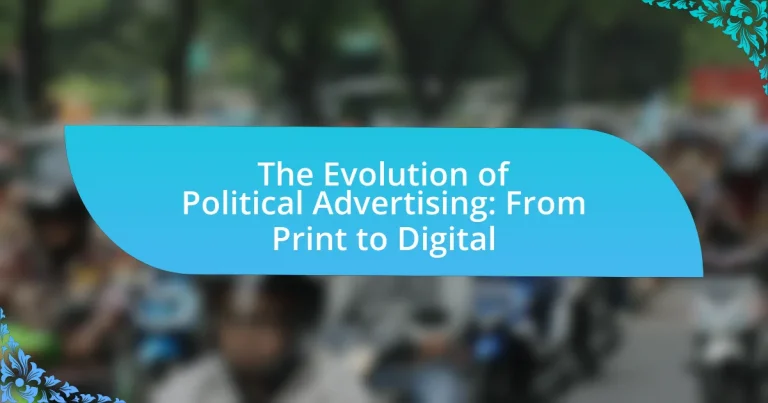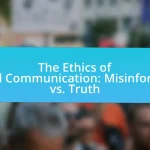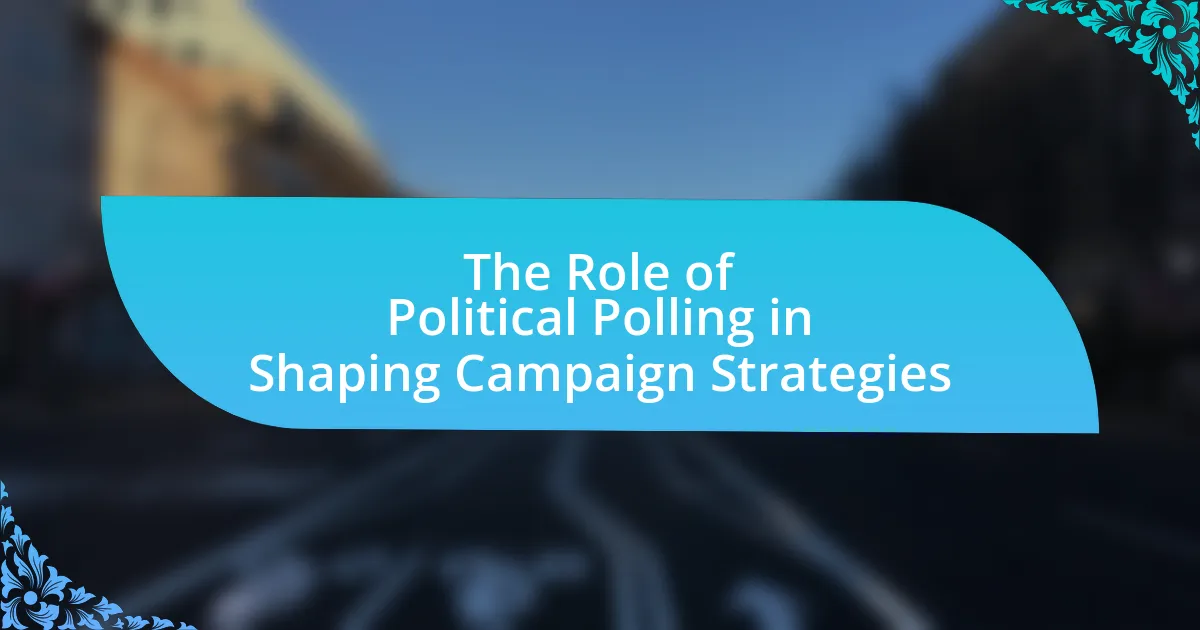The article examines the evolution of political advertising, tracing its development from traditional print media to contemporary digital platforms. It highlights key milestones, including the introduction of radio and television, and the transformative impact of the internet and social media on campaign strategies. The discussion covers how technological advancements have enabled targeted messaging and real-time voter engagement, as well as the ethical considerations and regulatory frameworks that shape modern political advertising. Additionally, it explores future trends and best practices for political campaigns, emphasizing the importance of data analytics and audience targeting in enhancing voter engagement.

What is the Evolution of Political Advertising?
The evolution of political advertising has transitioned from traditional print media to digital platforms. Initially, political advertising relied heavily on newspapers, pamphlets, and posters to reach voters, with the first recorded political advertisement appearing in the 1800s. The introduction of radio in the 1920s and television in the 1950s marked significant advancements, allowing candidates to convey their messages more dynamically and reach broader audiences. For instance, John F. Kennedy’s televised debates in 1960 showcased the power of visual media in shaping public perception.
With the rise of the internet in the late 1990s and early 2000s, political advertising further evolved, incorporating email campaigns and websites. The 2008 presidential election highlighted the effectiveness of social media platforms, as Barack Obama’s campaign utilized Facebook and Twitter to engage younger voters and mobilize grassroots support. By 2020, digital advertising had become a dominant force, with campaigns leveraging data analytics and targeted ads to influence voter behavior. This shift underscores the ongoing transformation of political advertising, adapting to technological advancements and changing voter preferences.
How has political advertising changed over time?
Political advertising has evolved significantly from traditional print media to digital platforms. Initially, political campaigns relied heavily on print advertisements, posters, and pamphlets to reach voters, with the first recorded political campaign advertisement appearing in the 1800s. As technology advanced, radio and television became dominant mediums in the mid-20th century, allowing candidates to convey their messages through audio-visual content, which increased engagement and reach.
In the 21st century, the rise of the internet and social media transformed political advertising by enabling targeted advertising based on user data, allowing campaigns to reach specific demographics more effectively. For example, during the 2008 presidential election, Barack Obama’s campaign utilized social media platforms extensively, setting a precedent for future campaigns. This shift has led to a more interactive and immediate form of political communication, where candidates can engage directly with voters and respond to issues in real-time.
What were the key milestones in the history of political advertising?
The key milestones in the history of political advertising include the introduction of printed pamphlets in the 18th century, the use of newspapers for political campaigns in the 19th century, the first radio broadcasts in the 1920s, and the advent of television advertising in the 1950s. The 2008 presidential election marked a significant shift with the extensive use of social media platforms for campaigning, demonstrating the transition from traditional to digital advertising methods. Each of these milestones reflects advancements in technology and communication, shaping how political messages are disseminated and received by the public.
How did technological advancements influence political advertising?
Technological advancements significantly transformed political advertising by enabling targeted messaging and real-time engagement with voters. The rise of digital platforms, such as social media and search engines, allowed political campaigns to analyze voter data and tailor advertisements to specific demographics, increasing the effectiveness of outreach efforts. For instance, during the 2016 U.S. presidential election, campaigns utilized data analytics to micro-target ads, resulting in a more personalized voter experience and higher engagement rates. This shift from traditional media, like print and television, to digital channels marked a pivotal change in how political messages are disseminated and consumed, ultimately reshaping the landscape of political communication.
Why is understanding the evolution of political advertising important?
Understanding the evolution of political advertising is important because it reveals how strategies and technologies have shaped voter engagement and influence over time. Political advertising has transitioned from print media in the early 20th century to digital platforms in the 21st century, reflecting changes in communication technology and audience behavior. For instance, the introduction of television in the 1950s revolutionized political campaigns, as seen in the 1960 Kennedy-Nixon debates, which highlighted the impact of visual media on public perception. Furthermore, the rise of social media has transformed political advertising into a more targeted and interactive process, allowing campaigns to reach specific demographics effectively. This historical perspective is crucial for understanding current practices and anticipating future trends in political communication.
What impact does historical context have on current political advertising strategies?
Historical context significantly shapes current political advertising strategies by influencing the methods, messages, and mediums used. For instance, the transition from print to digital advertising reflects historical shifts in technology and communication, such as the rise of television in the mid-20th century, which changed how candidates reached voters. The 2008 Obama campaign utilized social media effectively, marking a pivotal moment in digital strategy that built on earlier grassroots movements and media engagement tactics. This evolution demonstrates how past experiences inform contemporary approaches, as campaigns now leverage data analytics and targeted messaging, rooted in historical practices of voter outreach and persuasion.
How can lessons from the past inform future political campaigns?
Lessons from the past can inform future political campaigns by analyzing historical strategies and their outcomes to optimize messaging and targeting. For instance, the successful use of radio by Franklin D. Roosevelt in the 1930s demonstrated the power of direct communication with voters, which can be mirrored in today’s digital platforms like social media. Additionally, the 2008 Obama campaign effectively utilized data analytics to target specific demographics, a practice rooted in earlier campaign strategies that emphasized voter outreach and engagement. These historical examples illustrate that understanding past successes and failures can guide modern campaigns in crafting effective strategies that resonate with contemporary audiences.

What are the Different Phases of Political Advertising?
The different phases of political advertising include the pre-campaign phase, the campaign phase, and the post-campaign phase. In the pre-campaign phase, candidates build their brand and establish their message through various media, often utilizing polling data to refine their strategies. During the campaign phase, advertisements are actively deployed across multiple platforms, including television, radio, and digital media, to reach voters and influence public opinion. Finally, the post-campaign phase involves analyzing the effectiveness of the advertising efforts and engaging in follow-up communications to maintain voter relationships. This structured approach has evolved significantly with advancements in technology, particularly the rise of digital advertising, which allows for targeted messaging and real-time feedback.
What characterized print advertising in political campaigns?
Print advertising in political campaigns was characterized by its use of persuasive imagery and targeted messaging to influence voter perceptions. Historically, print ads utilized bold headlines, striking visuals, and concise text to convey candidates’ platforms and values, often appearing in newspapers, pamphlets, and posters. For instance, during the 1960 presidential election, John F. Kennedy’s campaign effectively used print media to project a youthful and dynamic image, which contributed to his electoral success. This strategic use of print advertising established a foundation for future political communication, emphasizing the importance of visual appeal and clear messaging in engaging voters.
How did newspapers and pamphlets shape early political messaging?
Newspapers and pamphlets significantly shaped early political messaging by providing a platform for the dissemination of political ideas and information to a broad audience. These printed materials allowed political leaders and activists to communicate their messages directly to the public, fostering informed citizenry and encouraging political engagement. For instance, during the American Revolution, pamphlets like Thomas Paine’s “Common Sense” effectively rallied support for independence by articulating the case against British rule, reaching thousands of readers and influencing public opinion. The widespread availability of newspapers further amplified political discourse, enabling diverse viewpoints to be shared and debated, which was crucial for the development of democratic societies.
What role did visual design play in print political ads?
Visual design played a crucial role in print political ads by influencing voter perception and engagement. Effective visual elements, such as color, typography, and imagery, were strategically used to convey messages, evoke emotions, and create memorable impressions. For instance, studies have shown that ads featuring strong visual contrasts and clear layouts significantly increased recall rates among voters, enhancing the overall impact of the political message. Additionally, historical examples, such as the use of bold graphics in the 1960 Kennedy-Nixon campaign, illustrate how visual design can shape public opinion and voter behavior.
How did radio and television transform political advertising?
Radio and television transformed political advertising by enabling candidates to reach a broader audience with more engaging and persuasive content. The introduction of radio in the 1920s allowed political messages to be broadcasted directly into homes, making it possible for candidates to connect emotionally with voters through their voices and personalities. Television further enhanced this by adding visual elements, which became crucial in shaping public perception; for instance, the 1960 Kennedy-Nixon debate showcased how televised appearances could influence voter opinions significantly. Studies indicate that candidates who effectively utilized these mediums often experienced increased support, demonstrating the profound impact of radio and television on political advertising strategies.
What were the first major political campaigns to utilize radio and TV?
The first major political campaign to utilize radio was Franklin D. Roosevelt’s 1932 presidential campaign, which effectively used the medium to reach a wide audience. The first significant use of television in a political campaign occurred during the 1952 presidential election, when Dwight D. Eisenhower’s campaign aired commercials that showcased his personality and policies. These campaigns marked pivotal moments in political advertising, demonstrating the power of emerging media to influence public opinion and voter engagement.
How did these mediums change voter engagement and outreach?
Digital mediums have significantly transformed voter engagement and outreach by enabling targeted communication and real-time interaction. Unlike traditional print media, which offered limited reach and delayed feedback, digital platforms such as social media and email allow campaigns to engage with specific demographics instantly. For instance, during the 2008 U.S. presidential election, Barack Obama’s campaign utilized social media to mobilize young voters, resulting in a 50% increase in voter turnout among that demographic compared to previous elections. This shift to digital mediums has facilitated personalized messaging, allowing campaigns to tailor their outreach based on user data and preferences, thereby enhancing voter participation and involvement in the electoral process.
What is the significance of digital advertising in modern political campaigns?
Digital advertising is significant in modern political campaigns because it allows for targeted outreach and real-time engagement with voters. This precision enables campaigns to tailor messages to specific demographics, increasing the likelihood of voter mobilization. For instance, a study by the Pew Research Center found that 69% of adults in the U.S. use social media, making it a crucial platform for political messaging. Additionally, digital advertising provides measurable analytics, allowing campaigns to assess the effectiveness of their strategies and adjust accordingly, which was notably utilized in the 2020 U.S. presidential election where digital ad spending reached over $1 billion.
How has social media changed the landscape of political advertising?
Social media has fundamentally transformed political advertising by enabling targeted messaging and real-time engagement with voters. Platforms like Facebook and Twitter allow political campaigns to analyze user data and demographics, tailoring advertisements to specific audiences, which increases the effectiveness of outreach efforts. For instance, during the 2016 U.S. presidential election, campaigns utilized social media to micro-target voters based on their interests and behaviors, resulting in a significant shift from traditional broad-spectrum advertising methods. According to a study by the Pew Research Center, 69% of adults in the U.S. reported using social media, highlighting its pervasive influence in shaping public opinion and voter behavior. This shift has led to a more interactive and responsive political advertising landscape, where candidates can quickly adapt their strategies based on immediate feedback from constituents.
What are the advantages and challenges of digital political ads?
Digital political ads offer advantages such as targeted reach and cost-effectiveness, while challenges include misinformation and regulatory scrutiny. Targeted reach allows campaigns to deliver messages to specific demographics based on data analytics, enhancing engagement; for instance, a study by the Pew Research Center found that 62% of adults receive news via social media, indicating the platform’s effectiveness in reaching voters. However, the challenge of misinformation is significant, as false narratives can spread rapidly online, undermining the integrity of political discourse. Additionally, regulatory scrutiny has increased, with platforms like Facebook implementing stricter ad policies to combat misleading content, which can complicate campaign strategies.

What are the Key Strategies in Political Advertising Today?
Key strategies in political advertising today include targeted digital marketing, data analytics, and social media engagement. Targeted digital marketing allows campaigns to reach specific demographics based on data-driven insights, enhancing the effectiveness of messaging. Data analytics plays a crucial role by enabling campaigns to assess voter behavior and preferences, allowing for real-time adjustments to strategies. Social media engagement fosters direct communication with voters, facilitating grassroots movements and increasing voter mobilization. According to a 2020 study by the Pew Research Center, 69% of Americans reported using social media, highlighting its significance in modern political outreach.
How do political campaigns target specific demographics?
Political campaigns target specific demographics by utilizing data analytics to identify and engage with voter segments based on characteristics such as age, gender, ethnicity, and socioeconomic status. Campaigns employ tools like voter databases, social media analytics, and surveys to gather insights about the preferences and behaviors of different groups. For instance, the 2020 U.S. presidential election saw campaigns using targeted ads on platforms like Facebook and Instagram, which allowed them to reach younger voters effectively, as 71% of 18-29-year-olds reported using these platforms for news. This data-driven approach enables campaigns to tailor their messaging and outreach strategies, ensuring that they resonate with the specific interests and concerns of each demographic group.
What data analytics methods are used to identify voter segments?
Data analytics methods used to identify voter segments include clustering analysis, regression analysis, and predictive modeling. Clustering analysis groups voters based on shared characteristics, such as demographics and voting behavior, allowing campaigns to tailor their messages effectively. Regression analysis examines the relationship between various factors, such as income and education level, and voting preferences, providing insights into how different segments may respond to specific issues. Predictive modeling utilizes historical voting data and demographic information to forecast future voting behavior, enabling campaigns to target their outreach more efficiently. These methods are supported by data from sources like the U.S. Census Bureau and voter registration databases, which provide the necessary demographic and behavioral data for analysis.
How do campaigns tailor messages to resonate with different audiences?
Campaigns tailor messages to resonate with different audiences by utilizing demographic data, psychographic insights, and targeted communication strategies. By analyzing factors such as age, gender, location, and interests, campaigns can create personalized messages that align with the values and concerns of specific groups. For instance, a study by the Pew Research Center found that younger voters are more influenced by social media campaigns, while older voters respond better to traditional media. This data-driven approach allows campaigns to optimize their messaging, ensuring that it is relevant and engaging for each audience segment.
What role does messaging play in effective political advertising?
Messaging is crucial in effective political advertising as it shapes voter perceptions and influences decision-making. Clear, targeted messaging resonates with specific demographics, allowing candidates to communicate their values, policies, and vision effectively. For instance, during the 2008 U.S. presidential election, Barack Obama’s campaign utilized messaging that emphasized hope and change, which significantly contributed to his appeal among younger voters and first-time voters. This strategic use of messaging not only differentiated him from his opponent but also mobilized a diverse voter base, demonstrating that well-crafted messages can enhance engagement and drive electoral success.
How do emotional appeals influence voter behavior?
Emotional appeals significantly influence voter behavior by tapping into the feelings and values of individuals, thereby shaping their perceptions and decisions. Research indicates that voters are more likely to respond positively to candidates who evoke strong emotions such as hope, fear, or anger, as these emotions can create a sense of urgency or connection. For instance, a study published in the Journal of Politics found that emotionally charged advertisements can increase voter turnout by as much as 20%, demonstrating the power of emotional resonance in political messaging. This effect is particularly pronounced in digital advertising, where visual and auditory elements can amplify emotional responses, making voters more susceptible to persuasive messaging.
What are the best practices for crafting compelling political messages?
The best practices for crafting compelling political messages include clarity, emotional resonance, and audience targeting. Clarity ensures that the message is easily understood, which is crucial in political communication where complex issues must be simplified for broader comprehension. Emotional resonance engages voters on a personal level, making them more likely to connect with the message; for instance, studies show that emotionally charged messages can increase voter turnout by up to 20%. Audience targeting involves tailoring messages to specific demographics, utilizing data analytics to understand voter preferences and behaviors, which enhances the effectiveness of the communication. These practices are supported by research indicating that targeted messaging significantly improves engagement and response rates in political campaigns.
What are the ethical considerations in political advertising?
Ethical considerations in political advertising include truthfulness, transparency, and the potential for manipulation. Political advertisements must accurately represent candidates and their positions to avoid misleading voters. Transparency involves disclosing funding sources and affiliations, which is crucial for maintaining public trust. Additionally, the use of emotional appeals and targeted messaging raises concerns about manipulation, as these tactics can exploit vulnerabilities in the electorate. Research indicates that misleading political ads can significantly influence voter perceptions and decisions, highlighting the importance of ethical standards in maintaining democratic integrity.
How do regulations impact political advertising strategies?
Regulations significantly shape political advertising strategies by imposing rules that govern content, funding, and transparency. For instance, the Federal Election Commission (FEC) in the United States mandates disclosure of campaign ad sponsors, which influences how candidates and organizations craft their messages to ensure compliance while maintaining appeal. Additionally, regulations like the Bipartisan Campaign Reform Act of 2002 restrict certain types of funding, compelling campaigns to adapt their financial strategies and prioritize grassroots fundraising over large donations. These legal frameworks directly affect the platforms used for advertising, as seen with the rise of digital advertising, where compliance with data privacy laws and platform-specific guidelines is essential for effective outreach.
What are the consequences of misinformation in political ads?
Misinformation in political ads leads to significant consequences, including voter manipulation, erosion of public trust, and polarization of political discourse. Voter manipulation occurs when false information sways public opinion or influences electoral outcomes, as evidenced by studies showing that misleading ads can alter voter perceptions and behavior. Erosion of public trust is evident when citizens become skeptical of all political messaging, undermining democratic processes; research indicates that exposure to misinformation correlates with decreased trust in institutions. Additionally, misinformation contributes to polarization, as individuals may gravitate towards extreme viewpoints based on false narratives, which can exacerbate societal divisions.
What are the future trends in political advertising?
Future trends in political advertising include increased use of artificial intelligence for targeted messaging, a focus on authenticity and transparency, and the rise of video content across social media platforms. Artificial intelligence enables campaigns to analyze voter data more effectively, allowing for personalized advertisements that resonate with specific demographics. Research indicates that 70% of voters prefer authentic messaging, prompting candidates to adopt more genuine communication strategies. Additionally, video content is projected to dominate online advertising, with platforms like TikTok and Instagram leading the way, as studies show that video ads can increase engagement rates by up to 120%.
How might emerging technologies shape the next generation of political ads?
Emerging technologies will significantly shape the next generation of political ads by enabling hyper-targeted messaging and real-time engagement with voters. For instance, advancements in artificial intelligence and data analytics allow campaigns to analyze voter behavior and preferences, tailoring ads to specific demographics with unprecedented precision. According to a 2020 study by the Pew Research Center, 72% of voters reported that they encounter political ads on social media platforms, highlighting the shift towards digital mediums where these technologies can be effectively utilized. Additionally, augmented reality and virtual reality can create immersive experiences, allowing voters to engage with candidates and their messages in innovative ways, further enhancing the impact of political advertising.
What skills will political advertisers need to adapt to changing landscapes?
Political advertisers will need skills in data analytics, digital marketing, and social media engagement to adapt to changing landscapes. As political advertising shifts from traditional print to digital platforms, understanding data analytics allows advertisers to target specific demographics effectively, optimizing campaign strategies based on real-time feedback. Proficiency in digital marketing techniques, including search engine optimization and content creation, is essential for reaching voters online. Additionally, strong social media engagement skills enable advertisers to interact with constituents directly, fostering community and responsiveness. These skills are supported by the increasing reliance on digital platforms for political communication, as evidenced by the 2020 U.S. election, where over 50% of campaign spending was directed towards digital advertising.
What best practices should political campaigns follow in advertising?
Political campaigns should prioritize transparency, targeting, and message consistency in their advertising efforts. Transparency involves clearly disclosing funding sources and affiliations, which builds trust with voters; for instance, the Federal Election Commission mandates that political ads identify their sponsors. Targeting ensures that campaigns reach specific demographics effectively, utilizing data analytics to tailor messages to various voter segments, as evidenced by the success of micro-targeting strategies in the 2008 and 2012 U.S. presidential elections. Message consistency across platforms reinforces brand identity and voter recognition, which is crucial in maintaining a coherent narrative, as seen in successful campaigns that align their messaging across social media, television, and print.
How can campaigns effectively measure the success of their advertising efforts?
Campaigns can effectively measure the success of their advertising efforts by utilizing key performance indicators (KPIs) such as conversion rates, return on investment (ROI), and engagement metrics. These metrics provide quantifiable data that reflect the effectiveness of advertising strategies. For instance, a study by the Interactive Advertising Bureau found that campaigns with clear ROI metrics were able to optimize their budgets and increase effectiveness by up to 30%. Additionally, tracking website traffic and social media engagement can reveal how well advertisements resonate with target audiences, further validating the success of the campaign.
What strategies can enhance voter engagement through advertising?
Targeted digital advertising enhances voter engagement by delivering personalized messages to specific demographics. This strategy utilizes data analytics to identify voter preferences and behaviors, allowing campaigns to tailor their content effectively. For instance, a study by the Pew Research Center found that 62% of Americans receive political news through social media, indicating the importance of digital platforms in reaching voters. Additionally, interactive content, such as polls and quizzes, can increase engagement by encouraging participation and fostering a sense of community among voters.

















